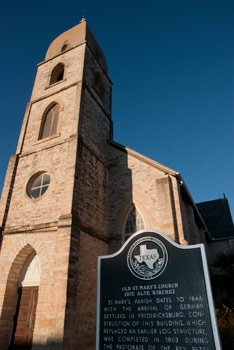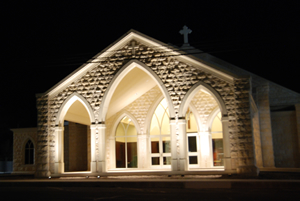






 St. Mary’s history goes back to the city’s founding. In 1847, the Catholics who were among the first settlers worshipped in the Vereins Kirche (Community Church), which had been erected in the middle of Main Street. The Catholics also assembled in the home of John Leyendecker, a local teacher at the time, where they held worship services without the ministry of a priest.
St. Mary’s history goes back to the city’s founding. In 1847, the Catholics who were among the first settlers worshipped in the Vereins Kirche (Community Church), which had been erected in the middle of Main Street. The Catholics also assembled in the home of John Leyendecker, a local teacher at the time, where they held worship services without the ministry of a priest.
In the fall of 1847, Father Dubois, a French priest who later became the first bishop of Galveston, and Father Salazar, a Spanish priest, arrived to hold mass. Although Father Dubois only stayed about two weeks, he encouraged the Catholics to build their own church. The congregation was promised a resident priest upon the completion of the church. In 1848, the congregation purchased a plot of ground for $18.00 on which to build the first church. The building, constructed of wood, was 40 feet long, 18 feet wide, and 15 feet high.
During the summer of 1849, Father Menzel, a native of Friedland, which is now Czechoslovakia, arrived to minister to the spiritual needs of the parishioners. When he left a year and a half later, tangible evidence of his presence remained. On a hill northeast of town, he had erected a large wooden cross to replace the remains of an earlier one erected by Spanish missionaries. The hill has been named Cross Mountain and it continues to serve as a memorial of the founding of Fredericksburg.
A succession of priests followed Father Menzel. During the early 1850’s, Father Tarillion, a secular priest, served the parish. During his stay, the first church bell was purchased for $115, and was delivered by Mr. Frank van der Stucken. In 1853, Bishop Odin came here to administer the sacrament of confirmation to the Catholics for the first time in the community. Father Zoeller served the congregation until February of 1858 and again in the spring of 1859 until the end of May that same year. The popular missionary, Jesuit Father Weninger, followed and stayed for three weeks. He made such an impression on the parishioners that when he left, they pleaded for him to return. He told them, “If you want me to return, build a new church.”
“Marienkirche” (Old St. Mary's)
 Father Baunach, a Benedictine priest, was here in 1861 when the first stone for the foundation of the new church was laid on February 26. The task of quarrying, stonecutting, lime burning, hauling sand and lumber, measuring and staking the foundation, masonry, carpentry, and plastering were undertaken by the parishioners. The building was completed on November 21, 1863 and dedicated by Bishop Dubois on November 22 of that year. The total cost of the building amounted to $7,797.
Father Baunach, a Benedictine priest, was here in 1861 when the first stone for the foundation of the new church was laid on February 26. The task of quarrying, stonecutting, lime burning, hauling sand and lumber, measuring and staking the foundation, masonry, carpentry, and plastering were undertaken by the parishioners. The building was completed on November 21, 1863 and dedicated by Bishop Dubois on November 22 of that year. The total cost of the building amounted to $7,797.
The church is built in cruciform, typical of early Christian churches. The two-foot thick limestone walls and large foundation blocks were quarried near Comfort, Texas. The roof was composed of hand cut rafters with cypress shingles nailed to wood lathing which spanned the rafters. The wood used was transported from Bastrop, Texas. The seventy-two foot steeple is the most prominent and distinguishing feature of the building. The corbel stone vaulting contributes to the uniqueness of the structure. Twelve Gothic arched windows, commemorating the twelve apostles, were made of cypress or cedar. The original clear glazed glass was soon replaced with blue cathedral glass. The ceiling consists of beaded board forming a vault over the nave and intersecting vaults at the transept crossing. Five six-pointed stars, from which lighting fixtures were suspended, were attached to the ceiling. Part of the floor was covered with blue-gray soapstone brought from Willow City. The floor under the pews was covered with wood. The entire structure was a very simple and honest architectural statement.
Father Tarillion returned on March 4, 1868, after spending most of his time in East Texas since his departure from here in 1856. During his administration at this time, a new rectory was built and an organ costing $500 was purchased. A ceiling for the church was constructed at a cost of $400 and paid for by Father Tarillion himself. The tower clock, which cost $500, was paid for in part by fellow citizens. It became known as the “Town Clock”, also the “Turm Uhr” (tower clock). In 1873, three additional bells for the church, amounting to $700, were purchased.
After the new church building was erected in 1905, the interior of “Marienkirche” (the old St. Mary’s church) was renovated to make it fit for use as a two-story school building. The Gothic windows were enlarged to make conventional windows for the classrooms that could be raised and lowered. The old church building has since been restored to its original design.
The structure is of such significance that the Department of Interior, while in the midst of taking note of historic structures in America, took not of old St. Mary’s and had its record placed in the Library of Congress. The Advisory Committee of the Historic American Buildings Survey deemed it to have “exceptional historic or architectural interest and as being worthy of most careful preservation for the benefit of future generations.”
The New Church Building
 Work on the new building was started in 1905 (the cornerstone was laid July 4, 1905) and is the third church built by St. Mary’s congregation of Fredericksburg since its founding in 1846. It is still referred to as “the new church” by many of the members. It is built of native stone quarried near the city and cost the church, furnished, about $40,000. It is an outstanding example of Gothic architecture here in the Southwest and the German influence is evident in many of its features. Mr. Leo Dielmann of San Antonio was the architect, and his father-in-law, Mr. Jacob Wagner, was the contractor and builder.
Work on the new building was started in 1905 (the cornerstone was laid July 4, 1905) and is the third church built by St. Mary’s congregation of Fredericksburg since its founding in 1846. It is still referred to as “the new church” by many of the members. It is built of native stone quarried near the city and cost the church, furnished, about $40,000. It is an outstanding example of Gothic architecture here in the Southwest and the German influence is evident in many of its features. Mr. Leo Dielmann of San Antonio was the architect, and his father-in-law, Mr. Jacob Wagner, was the contractor and builder.
The still functioning original pipe organ, built by George Kilgen & Son of St. Louis, Missouri, was installed in 1906. The church was completed in 1908 and was consecrated on November 24 of that same year. Most of the beautiful stained glass memorial windows were added in 1914-1915. However, the windows in the sanctuary were installed in 1906. The altars were made of wood and the main altar had an inset of the Last Supper in the front panel. The Stations of the Cross, whose design is very similar to the altars, were installed at the time the building was completed. The captions on the Stations were originally in German but were changed to English in 1936.
The first major redecoration took place under the able guidance of Monsignor Alfons Heckmann in 1936. At this time, all the elaborate stenciling and art work was done. Paintings of the twelve Apostles appear on the arches above the center aisle. Though Matthias was chosen to replace Judas, the Apostle Paul however was placed across from his historical counterpart, the Apostle Peter. Across the apse wall is the painting of Christ the King on His Throne. Surrounding the painting is the Latin inscription, "Ero Sum Pan De Vida", which means "I am the bread of life”. On the sanctuary walls are two more huge paintings. The one on the right is of Priest Melchizedek offering bread and wine to Abraham in thanksgiving for Abraham's rescuing of Lot from an enemy attack. The painting on the left is of Christ breaking bread with the two disciples at Emmaus. The two paintings are symbolic of Christ, King and Eternal Priest (New Testament) fulfilling the prophecy of Melchizedek, priest and king (Old Testament).
When the church underwent its second renovation and redecoration in 1970, as much of the artwork was retained as possible, as was the stenciling which was deteriorating rapidly due to moisture seeping through the thick rock walls. At this time, the new altar table of sacrifice and two lecterns were added to the sanctuary. The late Werner Weber, a local craftsman and longtime student of church architecture and design did the liturgical designs on these pieces.
For over one hundred years, the following prayer has been said at the conclusion of each mass and has become a very solemn and heartfelt tradition.
“Oh my Jesus, in union with all the angels and saints, I adore you in the most holy sacrament of the altar, in which you are concealed for the love of me. I adore you as my Lord and my God, my Creator and my Redeemer. Amen.”


